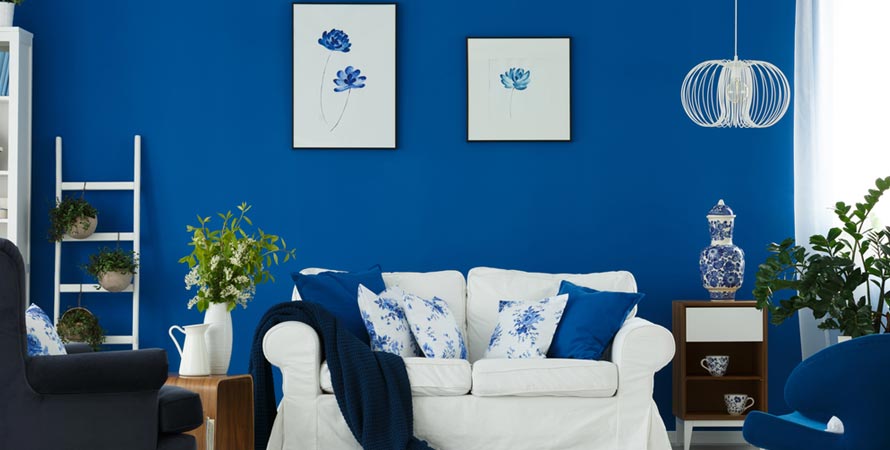Room Color Psychology: Does Room Color Affect Your Mood?

Introduction
Color psychology is the study of how various hues can affect and determine our behavior, mood, and emotions. It dates thousands of years back when the ancient Egyptians studied their effects on people and used them as symbols in their diverse practices.
Even though some perceptions of color are ultimately subjective, some have a universal meaning across almost everyone. For example, many men share that red colors complement female attractiveness.
A fascinating fact is that the human population has learned to associate blue and purple tones with toxic fruits. Moreover, studies show that these colors tend to decrease appetite, unlike yellow and orange.
Nowadays, marketers use color psychology in marketing and branding to attract customers by influencing emotions and predisposing us to buy subconsciously.
What Are the Ways to Introduce Colors Into Your Room
There are many ways to bring color inside your home and reach a desirable effect by bringing about specific hues and tones.
1. Paint the Whole Room
Probably the best way to give your room a completely new look and feel is to move out the furniture and paint all of the walls. You can stick to one color, but you can also paint one of the walls differently to add some accent.
The best colors for a bedroom are blue, yellow, green, orange and pink. On the other side of the spectrum, red boosts alertness and brain activity, while gray brings a feeling of a rainy day and promotes depression. Try to stay away from the last two if you’re painting a bedroom.
2. Add an Accent Wall
If you’d like to freshen up your room but don’t want to introduce the hassle of moving furniture in and out and making a mess, you can paint only one of your walls. For a bedroom, you can bet on blue, green, and purple to give you a sense of calm and tranquillity.
Depending on what you’re looking for, you can add different colors to reach a desirable effect.
3. Add up Some Colorful Accessories
Some rooms need a tiny bit of color here and there to reach the ultimate effect you’re looking for. Accessories are a simple and easy way to make your room look stunning. Toss in a few colorful pillows of your liking, get a few indoor plants, or pick up a new lamp. You can also add carpeting for some extra comfort and coziness.
How the Different Colors Affect Mood
1. Blue – Symbolic of Truth

Blue is a cold color that symbolizes calm, trust, peace, and relaxation. It reduces tension, frustration, and fear, along with reducing heart rate and appetite. Since it’s the favorite color of many people, businesses often use it to promote trust, loyalty, and stability.
You can use it in formal situations like job interviews, conferences, and other important business meetings. That’s why you can often find this color in banks, politics, insurance companies, and law firms.
Blue is a brilliant choice for your bathroom and bedroom.
2. Red – Symbolic of Passion
The warmest of all, red is a color of passion, love, adrenaline, and energy. It increases your heart and respiratory rate and boosts your metabolism. Ultimately, red’s effects on the brain are the opposite of blue. It’s motivating and pushes us to act. You can use it to draw attention, but you should use it moderately because it might overwhelm some people. Red is the color of strength and power, but also danger. Red is a perfect color choice for your living room, dining room, and entryway.
3. Green – Symbolic of Nature

Needless to say, green is the color of nature and is perhaps one of the most widespread colors around us. It brings a sense of balance, growth, calm, harmony, and stability. Green also means health, optimism, and new beginnings.
Nonetheless, darker green is the color of money and represents wealth and authority. Use it with moderation as too much green can provoke envy, greed, and jealousy.
Green is a color that’s easy on your eyes, and that’s why you can often see it in neurology and psychiatry clinics. It looks to relax and bring tranquility to the patients who often suffer from hyperactivity, anxiety, and nervousness. Green is suitable for bedrooms, living rooms, and kitchens.
4. Yellow – Symbolic of Happiness
Yellow has warm and cold tones, but it generally promotes energy, happiness, spontaneousness, and hope. We also associate it with intellect, creativity, motivation, and new ideas.
You can easily add it to your wardrobe or use it in accessories, but use it moderately as too much yellow can lead to opposite effects like agitation, anxiety, and stress. Add yellow to your living room, bathroom, and kitchen for some energy and happiness.
5. White – Symbolic of Purity

White is a minimalistic color that represents innocence, cleanliness, purity, light, and safety. Most commonly, the bride wears white to symbolize virginity and principles.
You can use white along with mirrors to make your room look bigger and more spacious. However, too much white can sometimes seem cold and sterile, making us associate it with hospitals and pharmacies.
It also represents mental clarity, stability, mindfulness, intelligence, pedanticism, and perfection.
White is suitable for every room in your home because of its neutrality.
6. Black – Symbolic of Mystery
Black represents class, strength, sophistication, and power. Furthermore, we associate it with luxury, elegance, and sex, but also simplicity and neutrality. Black also has a sense of mystery, expectation, and sometimes fear and frustration.
We often use this color to show sadness and mourning because of a close one’s passing or sickness.
Like white, black is suitable for any room.
Final Words
The various colors and their numerous tones and shades can influence your mood, emotions, and performance in many ways.
Look around your home and try to analyze the different colors and how they’ve been affecting you. You might want to introduce some changes to make your home even more comfortable.
Color psychology is real. You can now use it in your favor and be aware of how different brands and marketers are trying to affect you subconsciously.
Deprecated: Function WP_Query was called with an argument that is deprecated since version 3.1.0!
caller_get_posts is deprecated. Use ignore_sticky_posts instead. in /home/healthwebmagazin/skinformulations.com/wp-includes/functions.php on line 6121






